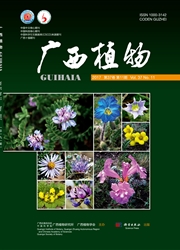

 中文摘要:
中文摘要:
胡黄连为特产中国-喜马拉雅特有高山植物,作为常用中、藏药材,受到灭绝性采挖,作为濒危和二级保护植物亟待科学的保护。该研究以云南和西藏7个野生居群91个个体为材料,基于cpDNA trnL-F非编码序列测序分析胡黄连的遗传多样性和遗传结构,分析显著进化单元,确立优先保护居群并提出科学的保护策略。结果表明:胡黄连trnL-F序列长度为871~876 bp,根据序列的核苷酸变异共鉴定出5个单倍型,西藏占有2个单倍型,云南占有3个单倍型,西藏和云南2个地区的所有单倍型均不共享。胡黄连具有较低的单倍型多样性(Hd=0.434 19)和核苷酸多样性(Dij=0.004 66)。种群间分化度(Fst=0.864 520)和基因流(Nm=0.04)、居群间的遗传分化水平(G_(ST)=0.916)、AMOVA分析(0.78%的遗传变异发生在居群内,60.97%的遗传变异发生在地区内居群间,38.25%的遗传变异发生在地区间)均表明,胡黄连居群间存在明显遗传分化。多数一致性树将胡黄连划分为3个进化分支(Ⅰ、Ⅱ、Ⅲ),这3个分支均与地理相关,分支Ⅰ分布于横断山区的4个居群,分支Ⅱ是分布于东喜马拉雅的一个居群,分支Ⅲ是分布于喜马拉雅中段的2个居群。3个分支分属于3个"进化显著单元(ESU)"。这3个ESU中白马雪山、茨中、定日、波密、聂拉木五个居群都需要保护,建议现阶段应优先保护的居群是云南白马雪山和西藏波密居群,以就地保护为主。
 英文摘要:
英文摘要:
Neopicrorhiza scrophulariiflora (Scrophulariaceae), a monotypic genus perennial species, is endemic to the Eastern Himalayas and the Hengduan Mountains region. It only distributes in Yunnan and Tibet in China, ranging from 3 600 m to 4 200 m in elevation. The long and creep rhizomes (Rhizoma Neopicrorhizae) are of high medicinal value and dysentery by traditional Chinese and Tibetan medicine. Mainly because of large-scale acquisitions activity, natural popu-lations of this species have suffered rapid declines and now it is classified as an endangered species under second catego-ry of key protected wild plants in China. In order to protect the decreasing natural genetic resources of N. scrophulariiflo-ra, in this study, the chloroplast DNA (cpDNA) trnL-F noncoding sequence was used to estimate the genetic diversity and genetic structure and the evolutionary significant units (ESU) were proposed. A total of 91 individuals of N. scrophu-lariiflora were collected from seven populations, covering almost all areas of its distribution ranges. Of these seven popu-lations, four were from Yunnan Province and three populations were from Tibet. The statistical results showed that the haplotype sequences length varied from 871 bp to 876 bp. A total of five haplotypes were detected based on trnL-F nucle-otide variation. Yunnan contains three haplotypes and Tibet contains two. However, none of common haplotypes were shared between the populations from Yunnan and Tibet. A normal low level of genetic diversity (Hd = 0.434 19) and nucleotide diversity (Dij = 0.004 66) were identified at the species level. A high level of genetic differentiation (0.96) among populations was revealed. AMOVA results from chloroplast data indicated that 0.78% of the genetic variation was partitioned within population, 60.97% among populations within groups, and 38.25% among groups under the condition that N. scrophulariiflora was divided into two groups including Yunnan and Tibet. The U-statistic test for phylogeographi-cal
 同期刊论文项目
同期刊论文项目
 同项目期刊论文
同项目期刊论文
 期刊信息
期刊信息
